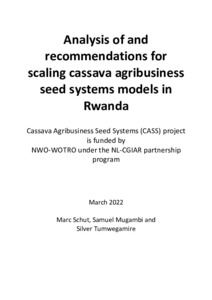| dc.contributor.author | Schut, M. |
| dc.contributor.author | Mugambi, S. |
| dc.contributor.author | Tumwegamire, S. |
| dc.date.accessioned | 2023-09-25T08:34:52Z |
| dc.date.available | 2023-09-25T08:34:52Z |
| dc.date.issued | 2022-03 |
| dc.identifier.citation | Schut, M., Mugambi, S. & Tumwegamire, S. (2022). Analysis of and recommendations for scaling cassava agribusiness seed systems models in Rwanda. Kigali, Rwanda: Cassava Agribusiness Seed Systems, (42 p.). |
| dc.identifier.uri | https://hdl.handle.net/20.500.12478/8256 |
| dc.description.abstract | The objective of this study was to analyze the scalability of the cassava seed agribusiness models that have been supported under the CASS project in Rwanda. Phone interviews with key-informants formed the basis for analyzing the agribusiness cases. The study presents general conclusions, bottlenecks and recommendations for further development and scaling of cassava agribusiness seed models in Rwanda. General conclusions The key-informant interviews allowed us to draw the following conclusions: 1. None of the seed agribusiness models are currently ready for scaling 2. Agribusiness models are not yet being used beyond the CASS project 3. Likelihood of continued agribusiness model development varies across models 4. There is a lack of strategies or plans that go beyond the CASS project 5. No major concerns regarding the responsible scaling of the agribusiness models are reported, but unclear how the models target different groups of cassava farmers 6. Public-private partnerships seem to be preferred modality for scaling cassava seed agribusiness models 7. The “what’s in it for me” needs to be clarified for key stakeholders Cross-cutting bottlenecks There are a number of sector-wide bottlenecks that could negatively affect the scaling of clean cassava seed agribusiness models in Rwanda: 1. Limited investment in developing the cassava sector 2. Incentives for investing in clean cassava seed are currently not strong enough 3. There exist key capacity gaps among cassava farmers, seed multipliers and cooperatives 4. There is a lack of clear stakeholder scaling role division and coordination 5. Limited understanding of the market for seed and roots 6. Limited information flow and demand creation amongst farmers for new varieties and clean seed Recommendations and next steps The following recommendations and next steps could be considered by the CASS project team: 1. Distinguish between scaling within the agribusiness cases, and scaling the agribusiness models 2. Develop long-term and/or exit strategies with the agribusiness case stakeholders 3. Continued investment in fine-tuning those models that seem promising 4. Deepen understanding of stakeholder willingness to pay/invest 5. Co-investment models with scaling partners to ensure ownership and sustainability The above conclusions, bottlenecks and recommendations are in line with the main objective of the CASS project which was to “develop, test and tailor different types of cassava agribusiness seed system models with and for different groups of farmers”. The nature of development, testing and tailoring implies by default that some models will show more 2 potential for sustainability and scaling than others. We would like to emphasize that this is normal and what should be expected when designing and piloting new seed system models. The scaling recommendations and bottlenecks identified in this report should therefore be interpreted as giving an early indication of how key-informants perceive the scalability potential of the various cases and models. Bottlenecks or risks should not necessarily stop agribusiness case or model development, but taken into account when making decisions on which case and model development to continue and how. What is very important is to see projects such as CASS as temporary interventions that can support capacity sharing, stakeholder collaboration or independent agribusiness seed model testing. Project teams and broader stakeholders should always think beyond the project to ensure that there is ownership, sustainability and continuity to ensure diverse groups of farmers have access to clean and affordable cassava seed. More detailed information on the conclusions, bottlenecks and recommendations can be found in Section 4. |
| dc.description.sponsorship | Dutch Research Council (NWO), The Netherlands |
| dc.format.extent | 42 p. |
| dc.language.iso | en |
| dc.publisher | Cassava Agribusiness Seed Systems |
| dc.subject | Cassava |
| dc.subject | Agribusiness |
| dc.subject | Food Security |
| dc.subject | Livelihoods |
| dc.subject | Rwanda |
| dc.title | Analysis of and recommendations for scaling cassava agribusiness seed systems models in Rwanda |
| dc.type | Report |
| cg.contributor.crp | Roots, Tubers and Bananas |
| cg.contributor.affiliation | International Institute of Tropical Agriculture |
| cg.coverage.region | Africa |
| cg.coverage.region | Central Africa |
| cg.coverage.country | Rwanda |
| cg.coverage.hub | Eastern Africa Hub |
| cg.researchtheme | Social Science and Agribusiness |
| cg.identifier.bibtexciteid | SCHUT:2022a |
| cg.authorship.types | CGIAR Single Centre |
| cg.iitasubject | Agribusiness |
| cg.iitasubject | Agronomy |
| cg.iitasubject | Cassava |
| cg.iitasubject | Farming Systems |
| cg.iitasubject | Food Security |
| cg.iitasubject | Plant Breeding |
| cg.iitasubject | Plant Production |
| cg.iitasubject | Smallholder Farmers |
| cg.iitasubject | Socioeconomy |
| cg.iitasubject | Value Chains |
| cg.publicationplace | Kigali, Rwanda |
| cg.accessibilitystatus | Open Access |
| cg.reviewstatus | Internal Review |
| cg.usagerightslicense | Creative Commons Attribution 4.0 (CC BY 0.0) |
| cg.targetaudience | Scientists |
| cg.iitaauthor.identifier | Marc Schut: 0000-0002-3361-4581 |
| cg.futureupdate.required | No |
| cg.contributor.acknowledgements | This publication is part of the IITA led CASS Project under the NL-CGIAR partnership programme which is financed by the Dutch Research Council (NWO).
The authors would like to acknowledge the important contribution made by the key-informants who shared their views and perspectives.
All photos used in this report – except photo 3 - were taken by Samuel Mugambi. Photo 3 was taken by Kigali Today and downloaded from: https://www.kigalitoday.com/ubuhinzi/ubuhinzi/Uruganda-rwa-Kinazi-ngo-nta-ngaruka-rwagizweho-na-COVID-19. |

